
The ultimate street signs, historical sites and house numbers
 Click for a larger image
Click for a larger image  Click for a larger image
Click for a larger image  Click for all signs belonging to Jerusalem - HaMesila Park - History of the railway line
Click for all signs belonging to Jerusalem - HaMesila Park - History of the railway line
 37 Meter |
37 Meter |  71 Meter |
71 Meter |  72 Meter |
72 Meter |  106 Meter |
106 Meter |  122 Meter
122 Meter